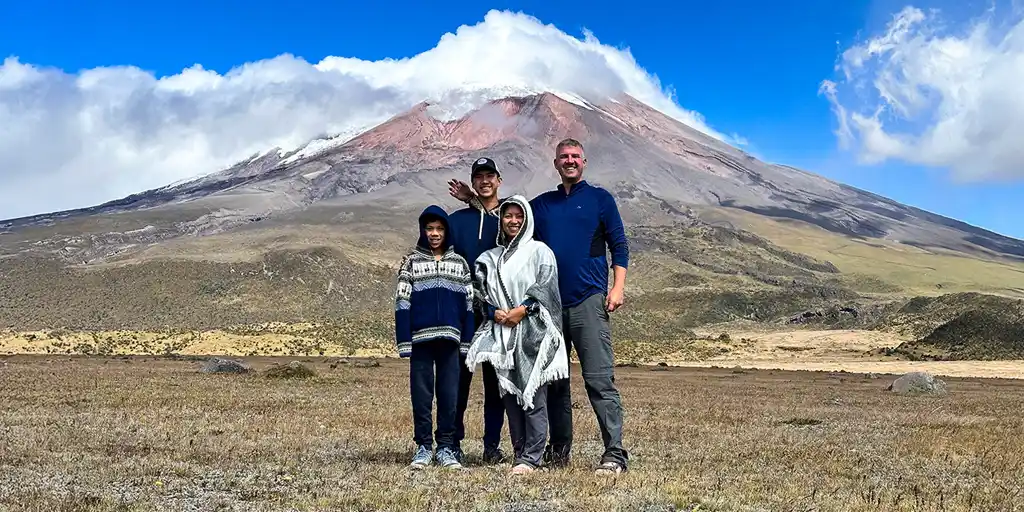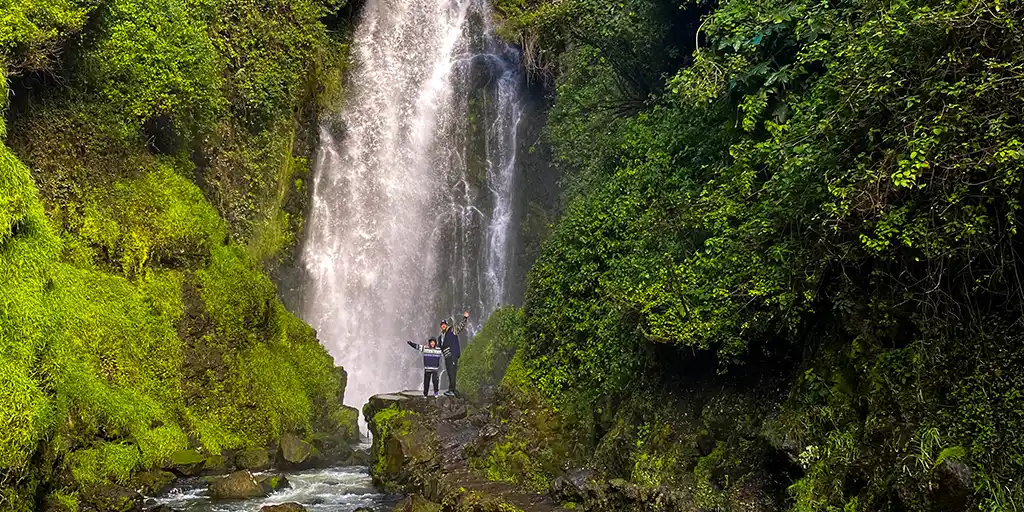Explore family travel to Otavalo, Ecuador! Immerse yourselves in lively indigenous markets, discover traditional music, find peace at Peguche Waterfall, and unwind at historic haciendas. Start planning your family’s memorable Andean journey!
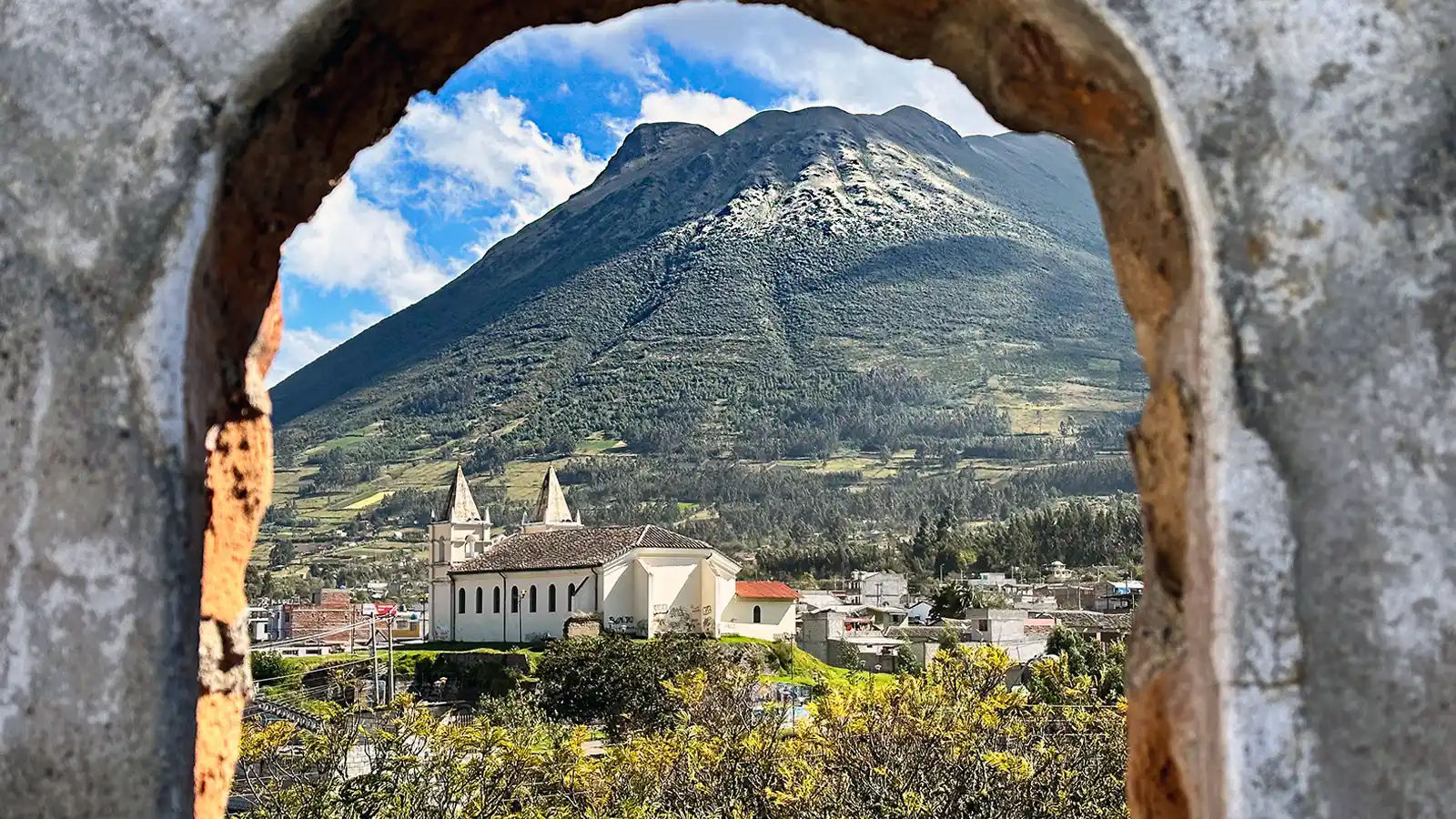
I’ll be honest, I didn’t know much about Otavalo, Ecuador, before my family made the drive north from Quito to the Imbabura province. Sure, I knew about this small city’s famous markets where rows of colorful stalls proudly display everything from textiles and artwork to produce and animals. But there had to be more things to do in Otavalo than just that.
Well, we had a couple of days to experience some of the wonders of Otavalo before heading back across the capital region toward the vast expanses of Cotopaxi National Park, so we decided to dive into the wonders of a town that completely took our breath away and truly began to shape Ecuador as one of our favorite family travel destinations.
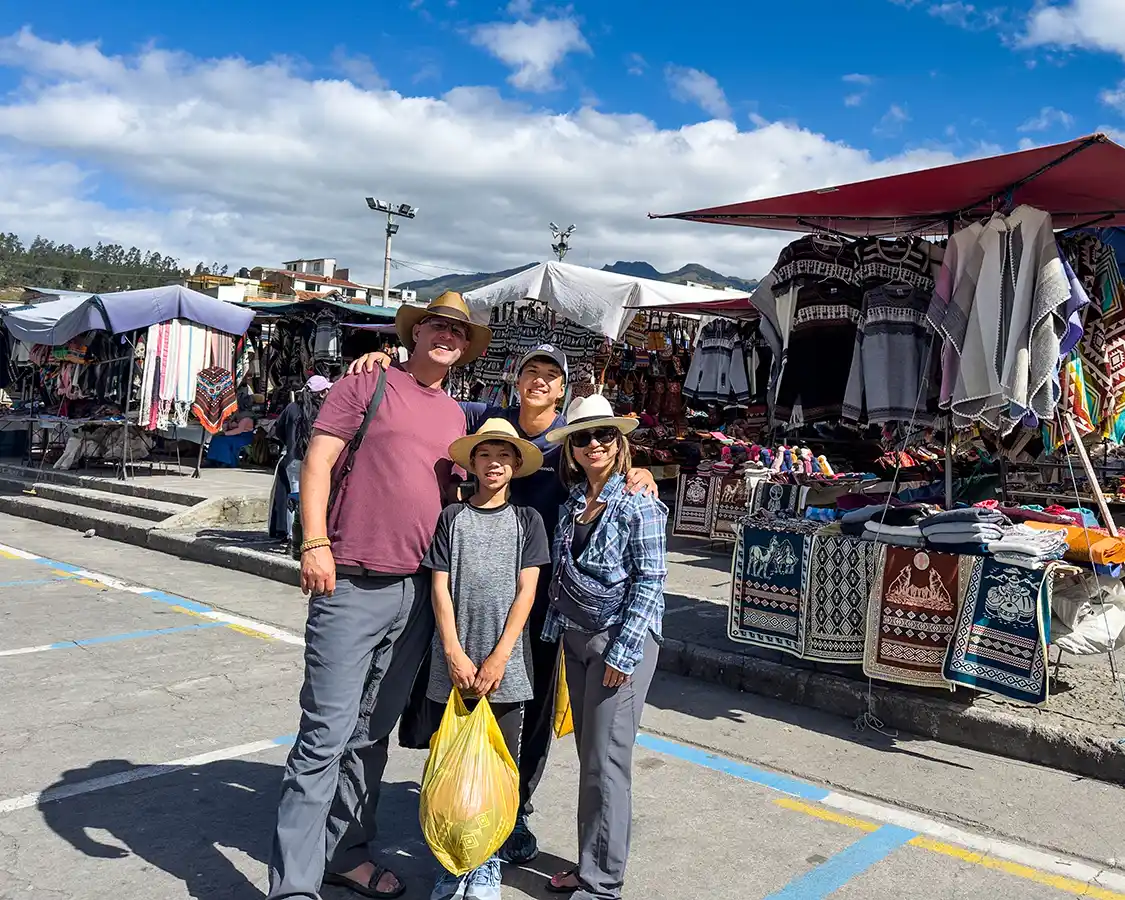
Our Otavalo itinerary brought us to those popular markets that draw people to Otavalo as a day trip from Quito, but it also uncovered some truly spectacular surprises, including an Indigenous run eco park with a gorgeous waterfall, a visit with a traveling musical family who crafts their own instruments, and a stay at a 400-year-old former monastery with million-dollar views.
For some help and advice on visiting Otavalo with kids, don’t miss my guide to the best accommodations in Otavalo for families and my complete guide to family travel in Ecuador.
If you’d like to dive into what my family’s travels through Ecuador were like, check out my Ecuador video on YouTube. Don’t forget to hit those like and subscribe buttons to help us out!
What We Did On Our Family Travels In Otavalo, Ecuador
The first thing that struck me about Otavalo as we rolled into town after a two-hour drive from Ecuador’s capital, Quito, was the colors. As my youngest son, Dylan, pointed out, everywhere we looked, there were gorgeous murals, vibrant textiles, and locals dressed in radiant shades of red, blue, green, and yellow. And as we would soon see, this was just a taste of the beauty and artistic excellence of the region.
Learning About Otavalo’s Musical Culture
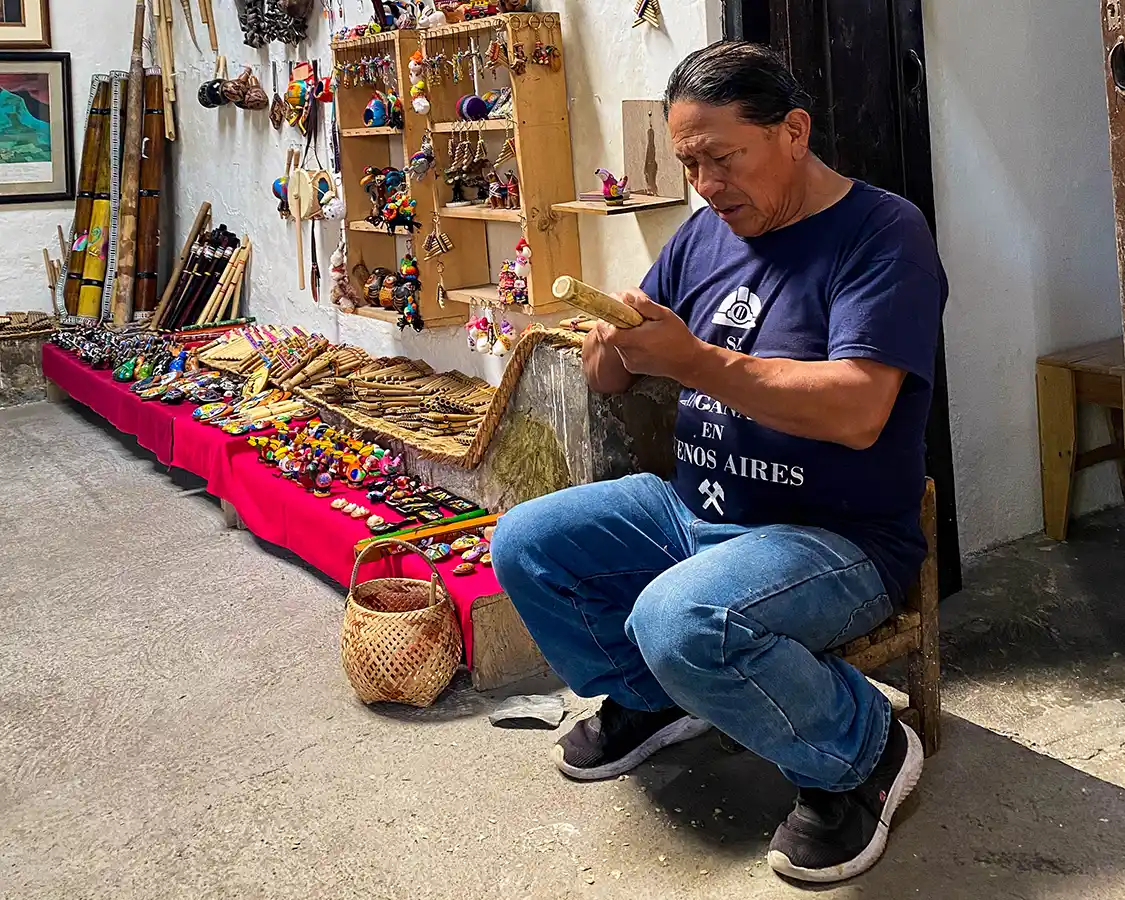
Otavalo and its surrounding towns are renowned for their rich Indigenous culture. The Otavalo Peoples, who can be found both in Otavalo and the surrounding Imbabura Province, are Kichwa-speaking and have a rich musical tradition that dates back to pre-Hispanic times.
To learn more about the music of the region, we made a visit to the Ñanda Mañachi Group at their shop, Taller de Instrumentos Andinos. The Ñanda Mañachi Group has been a vital part of the resurgence and education of traditional Andean music.
The shop, a small adobe building on a side street, doesn’t scream history and world-class musicians, but as we stepped inside and were greeted warmly by José Luis Pichamba, the current director of the Ñanda Mañachi Group, it was clear that we were in the presence of a family of deeply passionate musicians and instrumental artists.
Cohen and Dylan, who both play their own instruments (Cohen plays guitar and Dylan plays the drums), were immediately caught by the plethora of unique musical instruments, many of which none of us had ever seen before.
José and his family are Otavalos, and along with crafting instruments, he travels the world bringing Andean sounds to everyone from families to celebrities and royalty. Our local guide, Angel Rea, who runs a company called Quinde Adventure, translated the stories of each of the instruments as José walked us through the many tools of his trade.
My father is a musician who also traveled the world playing Canadian folk tunes, so I was captured by everything that was being said. As for Christina and the boys, what blew them away was how José sat, telling us stories while simultaneously crafting a small flute right before our eyes. It was truly astounding. You can check out their Facebook page here.
After José had finished demonstrating some of the instruments and sharing some traditional music with us, Christina really had to work to stop me from buying far more instruments than we could possibly carry in our carry-on bags.
Maybe they deliver?
Visiting The Otavalo Markets

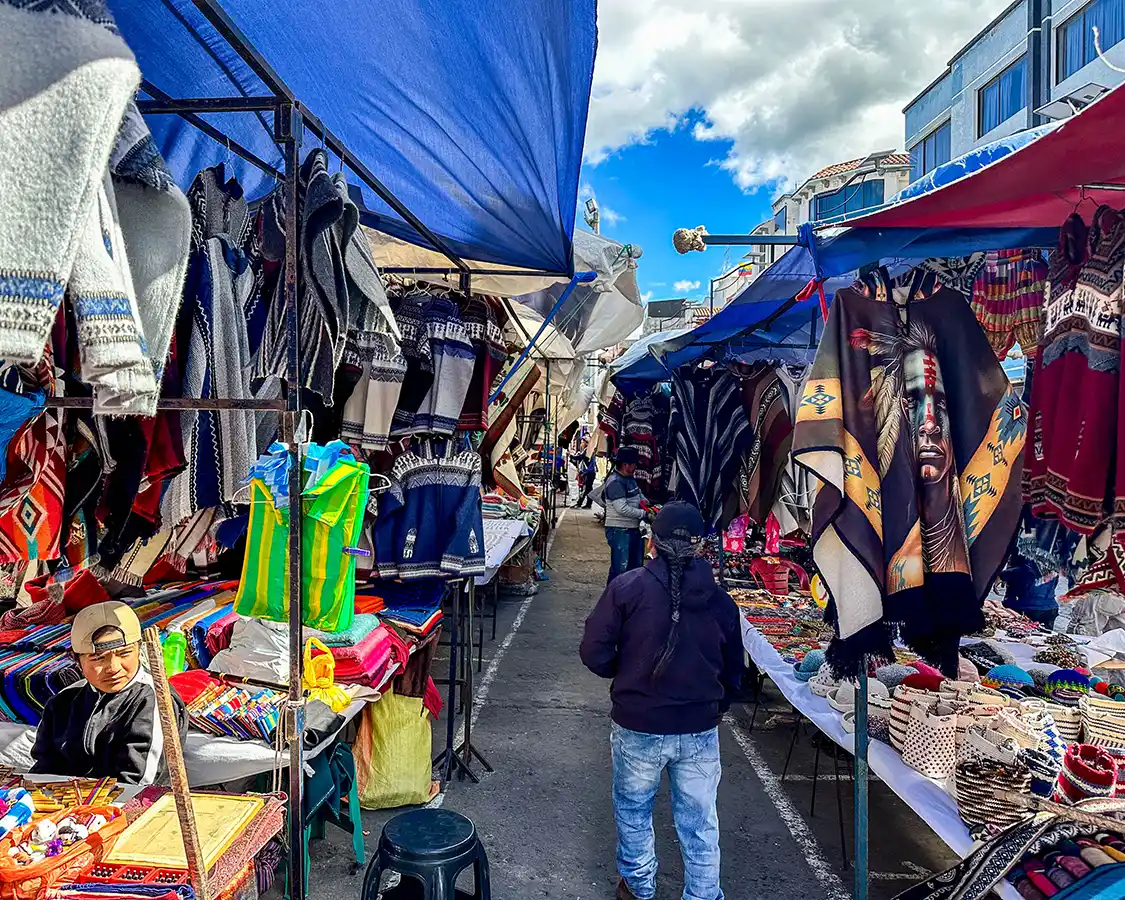
When a place is known for being the largest Indigenous market in Latin America, it garners some attention. But the Otavalo Market isn’t what many people imagine. Sure, the rich energy and gorgeous displays are breathtaking, but it’s actually three different markets set in locations across the town. And each of those markets has its own unique focus.
We went on a Monday, probably the quietest day of the week, to visit the Otavalo markets. The most active days are Saturdays and Wednesdays, when the markets spill out from places like Plaza de Ponchos into the surrounding neighborhoods. But the markets are active all week long in some capacity.
The Otavalo markets are made up of three unique markets. One for textiles, one for food, and one for animals. Our focus was on souvenirs and some sweaters to help keep us warm in the Andean Highlands. With that in mind, we hit up the textile market and picked up some creative and comfortable sweaters, alpaca ponchos, and Panama hats (known locally as toquilla straw hats or Jipijapa hats).
The animal market is focused on animals for farming or butchering. So if you’re hoping to hit all three of the Otavalo markets with your kids, please keep that in mind. It’s a real market, not a tourist experience, so there may be items that make some families uncomfortable.
The Otavalo Market is, perhaps, the coolest shopping experience in Ecuador. Bright stalls, friendly locals, and exciting and unique products that had us, quite honestly, wishing that we’d brought a bigger bag. But with a Galapagos cruise ahead of us, we knew we had to limit any bulky purchases.
Stand Beneath Cascada de Peguche (Peguche Waterfall)
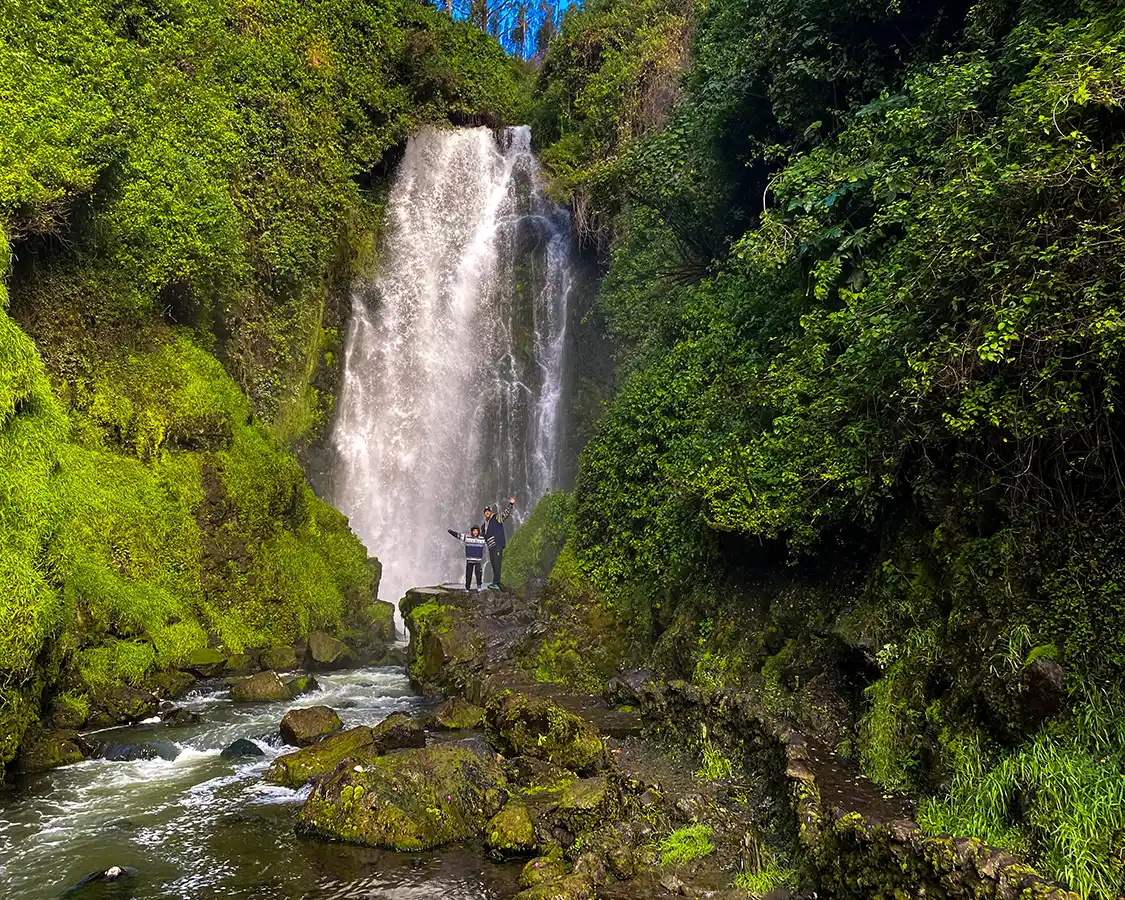
One of the most surprising experiences on my family’s visit to Otavalo was just a short distance from the city in the small Indigenous town of Peguche. We made the easy drive to a long, narrow parking lot. There, it was clear that this was a favorite destination among locals in the city. Families poured from their cars, some with picnic baskets in hand for a day on the trails.
A quick walk through town led us to the park’s entrance, where we paid a small fee for access to a collection of well-maintained trails that led us among small art installations set amongst the trees, all leading to the park’s main attraction, a 60-foot-tall ribbon waterfall dividing a narrow gorge filled with greenery.
Cascada de Peguche, or Peguche Waterfall, is one of the most beautiful natural experiences near Otavalo. We crossed a series of bridges that gave amazing views of the waterfall. We also found a small, roped-off area where, for a very tiny fee (about $0.50 equivalent), we could get even closer to the falls for a very cool photo stop. Now, I’m not sure if this Cascada de Peguche “bonus” is something that we were actually allowed to do, or if we just donated some pocket change to a local for an unsanctioned experience, but it’s worth asking about just in case.
The waterfall is fed by the Laguna San Pablo and connects to the Jatun Yacu River. And beyond the beauty of the waterfall and the park, I loved that it’s completely Indigenous-run, and that the money for access goes back into maintaining and growing the park and the community.
The waterfalls are sacred to the local Kichwa people, so be sure to treat the water and the land with respect. It’s also the site of several local festivals. During June’s Festival of the Sun, known as Inti Raymi, locals often conduct a ritual cleansing, bathing in the waters of the river, and a market pops up along the cobblestone trails leading to the waterfall.
Hacienda Cusin
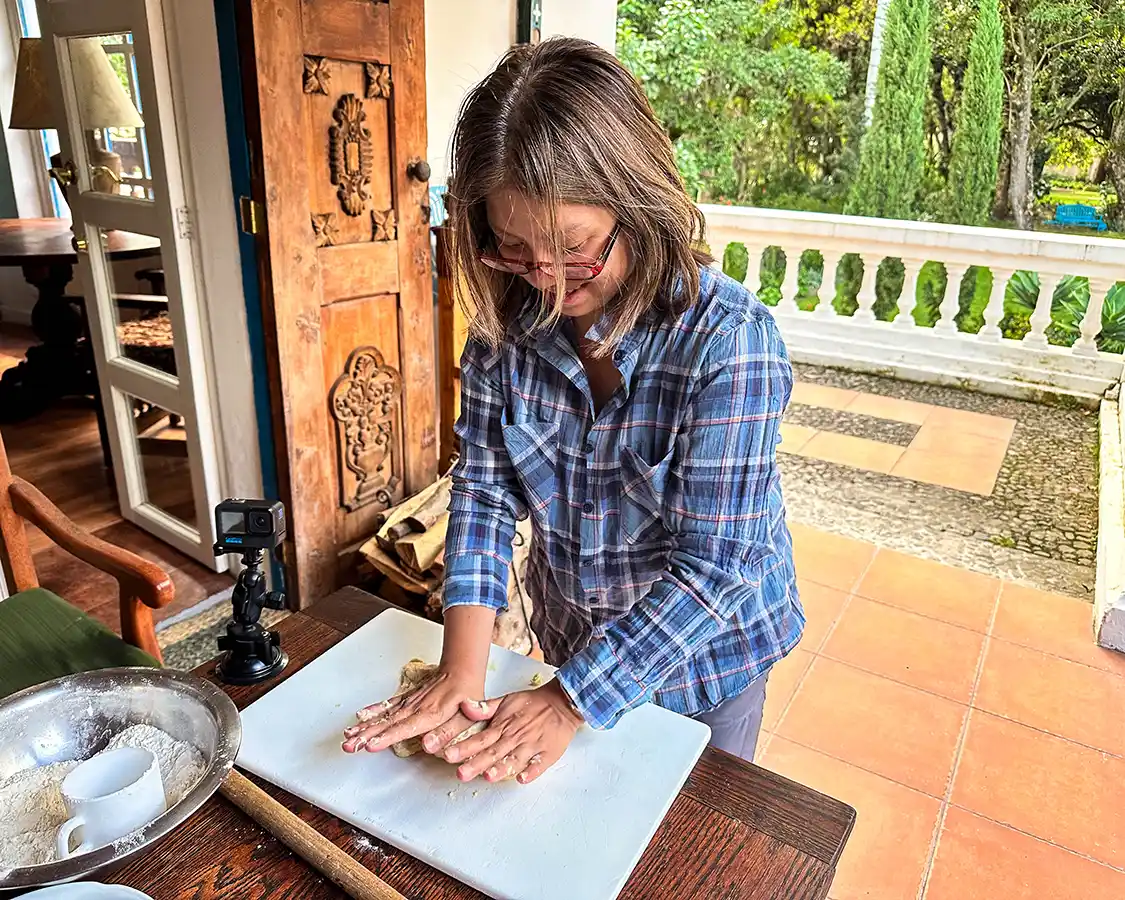
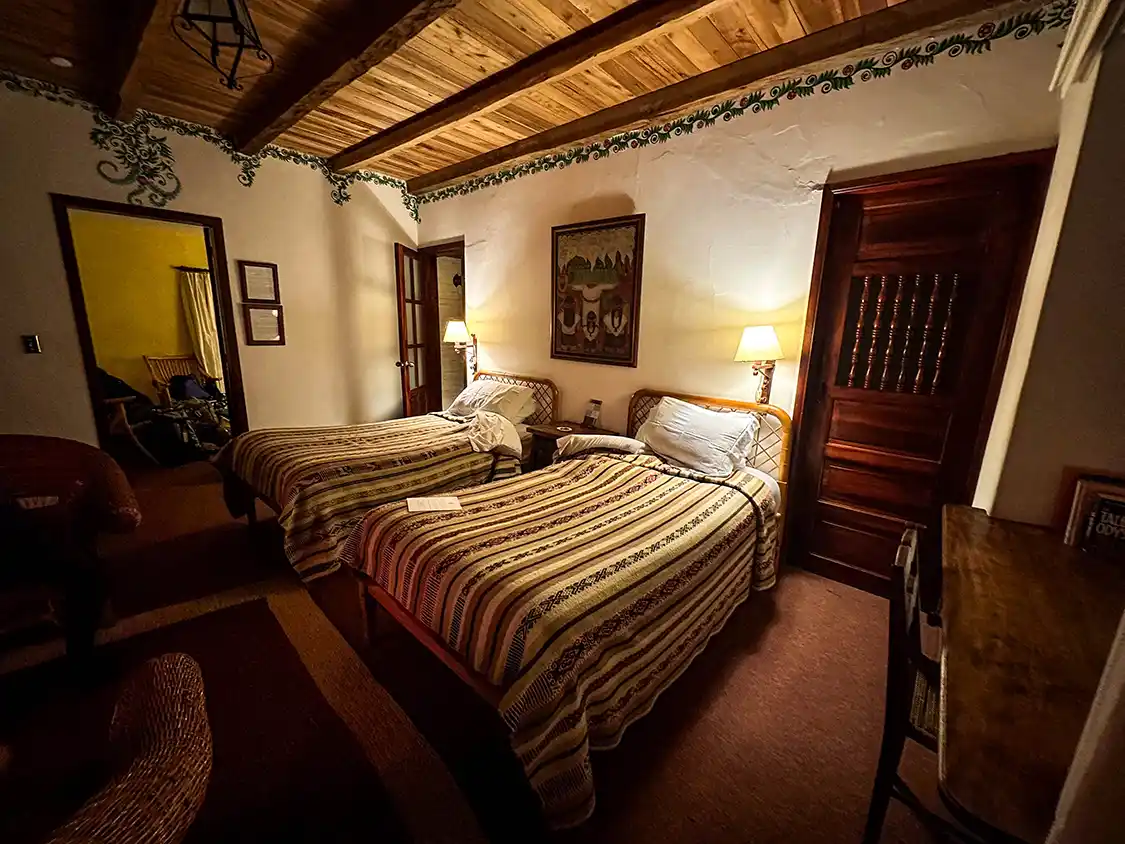
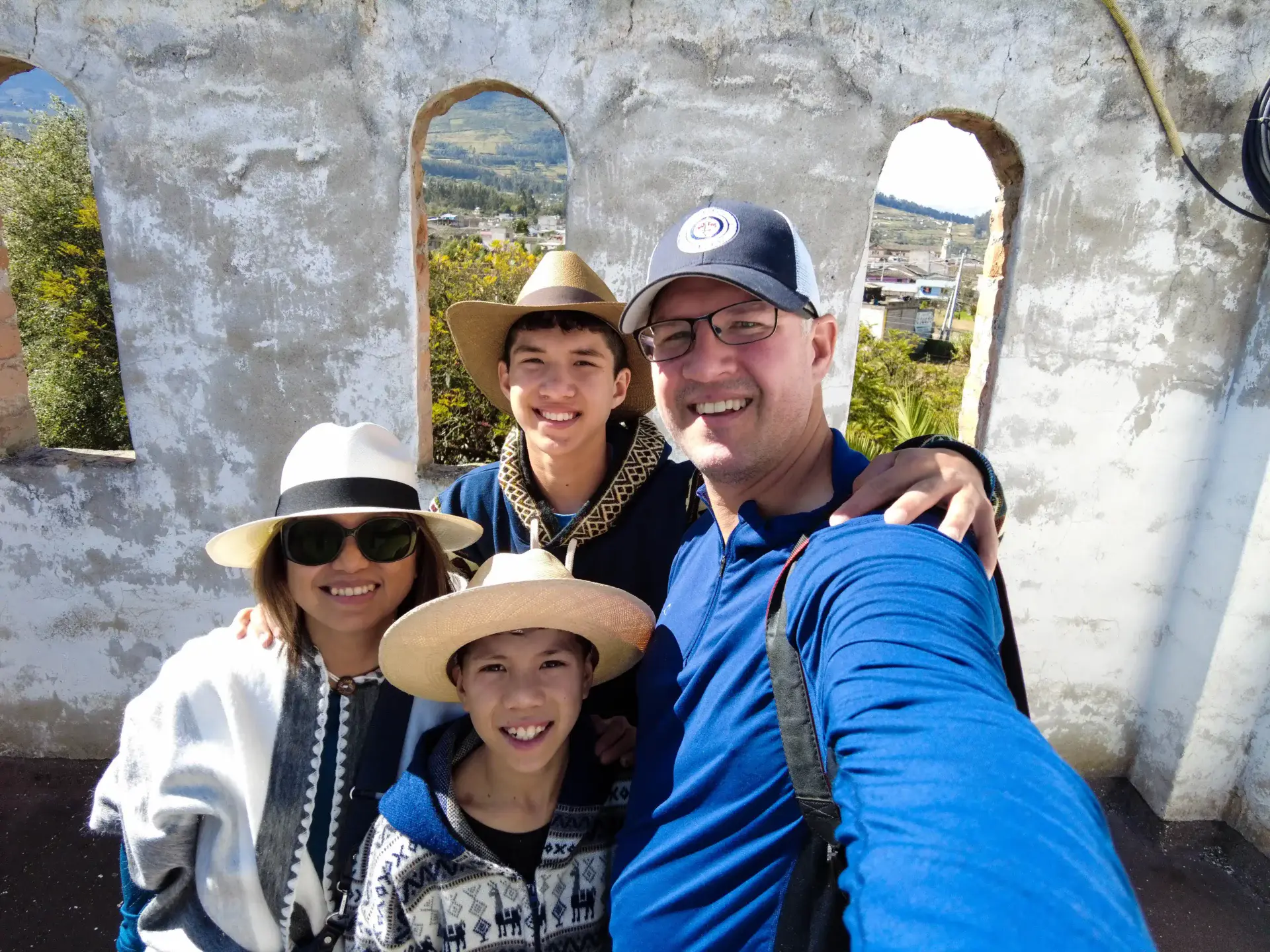
One of the most popular things for families to do in Otavalo is to stay at one of the town’s historic haciendas. These historic estates, often sprawling ranches or quiet monasteries, offer a step away from the urban bustle into a time when massive change was occurring within the country.
It was hard to choose from all the incredible places to stay for families in Otavalo, but we ultimately chose Hacienda Cusin, a converted former estate that dates back more than 400 years. The property dates back to 1602, when the Luna family bought the land from King Philip III of Spain. Today, this sprawling estate, which includes lodging within the estate along with a connected monastery, offers a taste of that historic luxury.
Along with stunning accommodations, there are loads of immersive activities at Hacienda Cusin. One of our top memories was taking part in an empanada cooking class with the hacienda’s chef. The two-hour experience was a lot of fun. The boys, and even Christina and I were completely immersed and it inspired us to bring those cooking skills back home to Canada.
Walking through the extensive grounds and gardens was also a treat. If you come here, make sure to wander over to the monastery and bell tower. Inside the base of the tower is a secrety door (you’ll have to figure out how to open it), that opens to a hidden staircase to the top of the tower. The view at the top is gorgeous, although the stairs to the roof are questionable from a safety perspective.
Quite honestly, I would have loved to spend a few days at Hacienda Cusin just soaking in the atmosphere and the serenity. The rooms were well-adorned, comfortable, and harkened back to a time when life was uncomplicated. A wood-burning fire, cozy blankets, and dim lighting.
If you’re looking for a great place to stay for families in Otavalo, you can check out their rates and availability here.
Practical Tips for Visiting Otavalo With Kids
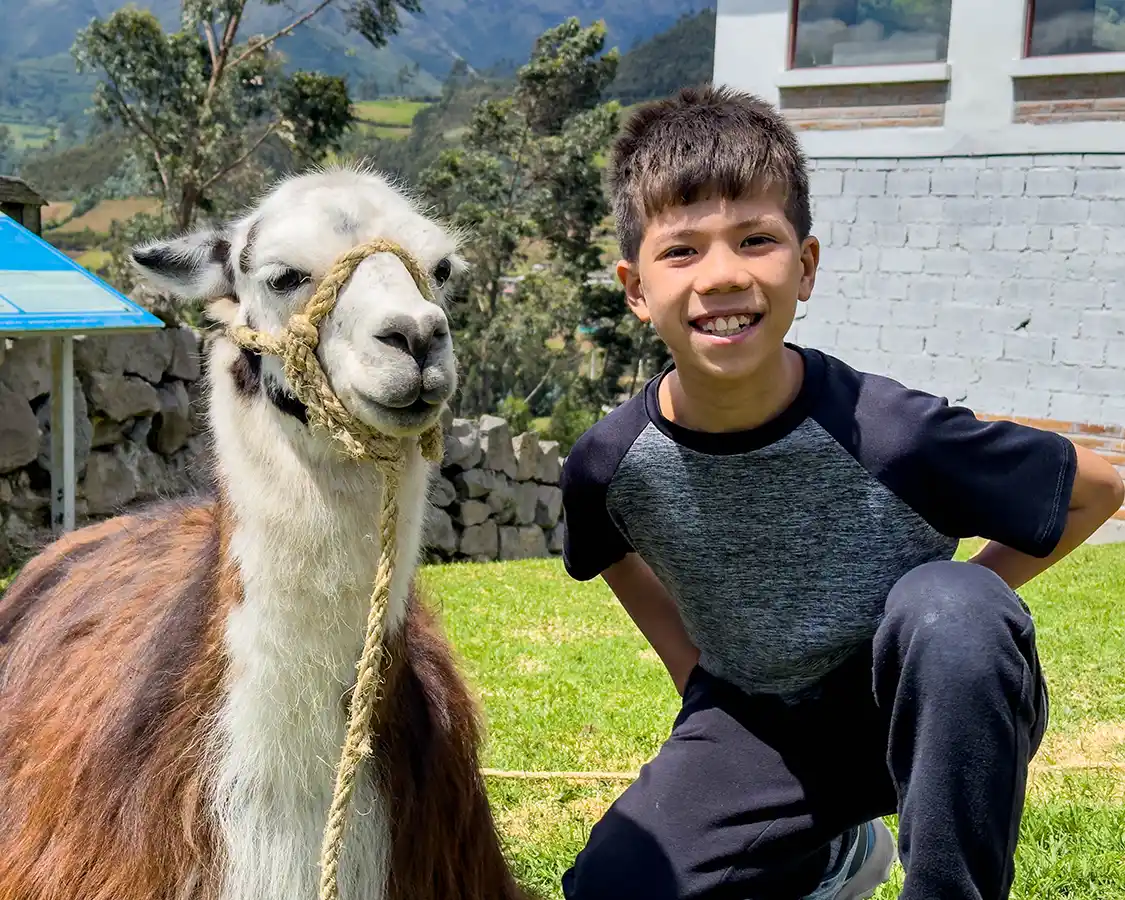
Otavalo, like any unique destination, needs a little bit of planning in order to make the most of it. If you’re planning a trip to this one-of-a-kind town, here are a few things you’ll want to consider before you go:
What’s the Best Time To Visit Otavalo?
Otavalo is an amazing destination all year round. The weather here is similar to Quito’s, so you can expect a lot of variability, even throughout a single day. Temperatures typically run between 8°C (46°F) and 22°C (72°F) with a mix of sunshine and rain. October to May tends to be the rainy season, while June through August is the dry season.
If you want to see Otavalo at its liveliest, consider visiting on a Saturday when the Otavalo markets are at their busiest. Along with plenty of foreign tourists, loads of Ecuadorian locals stream in from cities like Cuenca and Quito as well.
For a quieter visit like ours, consider visiting on Wednesdays when the market is at its height or during the rest of the week when the crowds are at their lightest.
How Long Should You Spend In Otavalo?
I’ll be honest, our two-day and one-night Otavalo itinerary felt a bit rushed. I’d highly recommend spending three to four days in the region in order to fully experience all of the memorable things to do in Otavalo properly.
Is Otavalo Safe For Families?
There have been a lot of concerns raised among family travelers in Ecuador about safety. And it’s true that there are some areas of the country that are currently experiencing some unrest, but most of these are around the coast.
I’ll say straight out that my family didn’t visit the coastal regions of the country on our visit, but this was due to our itinerary, not safety concerns. We never felt unsafe and experienced only well-meaning locals during our visit.
Otavalo is considered among the safest destinations in Ecuador, and travel here should include only standard family travel safety precautions.
More Amazing Places To Visit In Otavalo
If you’ve got some extra time in Otavalo and you’d like to add a few more items to your itinerary, you’ll have a lot of options. Here are a few things that I wish my family could have added to our things to do list:
Otavalo Textiles
For an authentic glimpse into Otavalo’s renowned textile heritage, a visit to a local weaving workshop offers a more immersive and less commercial experience than the bustling market stalls. These workshops, some of which can be visited as part of local tours, showcase the time-honored traditions of Otavalo’s weavers, whose craft dates back to pre-Columbian times.
Visitors can witness the creation process behind the region’s high-quality, handcrafted textiles—from ponchos and blankets to scarves and tapestries—each piece distinguished by vibrant colors, intricate designs, and the unique cultural symbols of the Otavalo people, a stark contrast to the mass-produced items often found in the main market.
Otavalo Homestays
For those seeking to truly experience the traditional Otavalo way of life, a homestay with an indigenous family offers an unparalleled opportunity for cultural immersion. Communities such as San Clemente are particularly known for welcoming tourists into their homes, providing an authentic glimpse into daily life.
Guests can participate in preparing and sharing traditional meals, learn about activities like herding llamas, and discover local crafts such as embroidery. These homestays also often provide exposure to the rich musical and dance traditions of the Otavalo people. If your visit aligns with a local festival like the Inti Raymi (summer solstice), you’ll have the added bonus of experiencing vibrant celebrations complete with ancient rituals, music, and dance that often extend late into the night.
Parque Cóndor: A Haven for Birds of Prey
For a unique experience that combines stunning views with a focus on wildlife conservation, a visit to Parque Cóndor is highly recommended. This park is dedicated to the preservation and rehabilitation of various birds of prey, with a particular emphasis on the majestic Andean condor.
You’ll encounter a diverse collection of raptors, including hawks, eagles, falcons, and owls, many of which have been rescued from injury or captivity. A highlight of any visit is catching one of the daily flying demonstrations, held at 11:30 AM and 3:30 PM, where you can witness these magnificent birds in action and learn about their importance from a local guide. Parque Cóndor is open Wednesday to Sunday from 9:30 AM to 5:00 PM, with an entry fee of $4.50.
Day Trip To Cotacachi Town & Cuicocha Lake
For a fantastic day trip from Otavalo, consider combining a visit to Cotacachi Town with the stunning Cuicocha Lake. Cotacachi, located just 25 kilometers from Otavalo, is renowned for its high-quality leather goods, with numerous shops lining its main street. From Cotacachi, it’s an easy 12-kilometer journey to Cuicocha Crater Lake, a breathtaking natural attraction within the Cotacachi-Cayapas Ecological Reserve.
This caldera lake, formed by a volcanic eruption over 3,000 years ago, offers dramatic views of its deep blue waters surrounded by steep crater walls and lush vegetation. For those who enjoy hiking, the Cuicocha Loop Trail provides an approximately 14-kilometer path circling the entire lake, offering incredible panoramic vistas.
Mojanda Lakes & Fuya Fuya Volcano
For a truly stunning natural escape from Otavalo, consider a day trip to the Mojanda Lakes and the adjacent Fuya Fuya Volcano. Located about a 45-minute drive from Otavalo along a rough, unpaved road (taxis are available, just arrange your return trip), Mojanda is a series of three interconnected crater lakes—Caricocha, Huarmicocha, and Yanacocha—nestled at an elevation of approximately 3,700 meters (12,140 feet).
The rugged mountains and breathtaking landscapes surrounding the lakes offer spectacular views, but be sure to pack warm clothing and plenty of water due to the altitude. For the most panoramic vistas, intrepid hikers can trek to the summit of Fuya Fuya Volcano, which, at 4,263 meters (13,986 feet), provides a challenging yet truly rewarding ascent with unparalleled views of the lakes and the majestic Andes.
Family-Friendly Tours In Otavalo
If you’re looking to fill some time during your family visit to Otavalo, I’ve rounded up a few amazing tours available through Viator and Get Your Guide that are perfect for adventurous families.
🐢 Plan Your Own Otavalo Adventure
Ready to dive deeper into Otavalo? These hand-picked tours from Viator and GetYourGuide make it easy to explore wildlife, landscapes, and culture with your family.
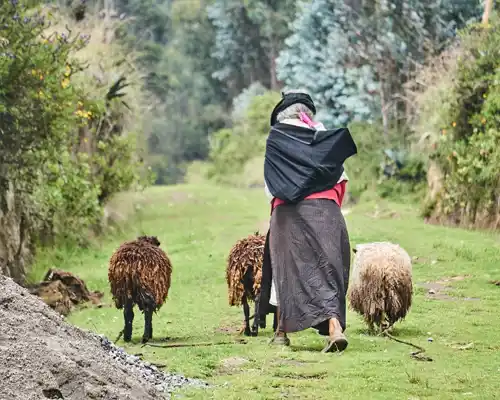
Full Day Indigenous Culture Tour
Experience the true land of Coraza and the traditional way of life of the indigenous people in this tour through unique and exclusive places you will know and live closely the tradition and culture of the indigenous people.
Book on Viator →
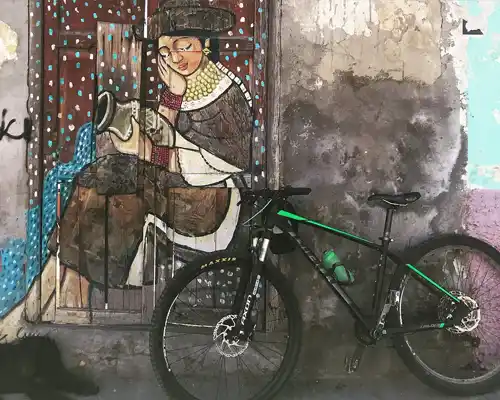
The Best of Otavalo Bike Tour
Among the major attractions of Imbabura are Lake San Pablo; Otavalo and its indigenous market; the Peguche waterfalls; Chachimbiro and its thermal waters; Cuicocha lagoon, guarded by the imposing Cotacachi; Cotacachi, famous for its leather industry; Atuntaqui, an icon of Ecuadorian fashion; the beautiful Urcuquí valley with its arid areas; and the mysterious Zuleta area, renowned for its embroidery.
Book on Viator →
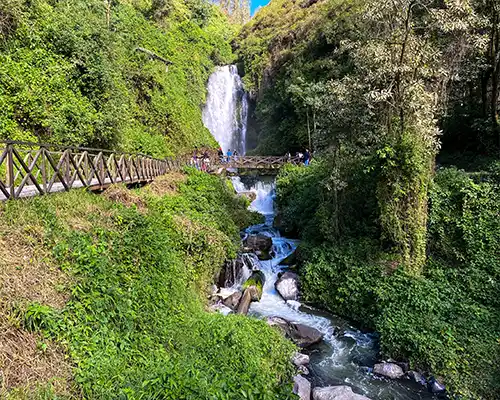
Private Otavalo Day Tour
isit one of the most popular and spectacular local markets in Latin America on a full-day tour from Quito. Shop unique souvenirs at Otavalo Market and get breathtaking views of the Andes Mountains.
Book on Get Your Guide →
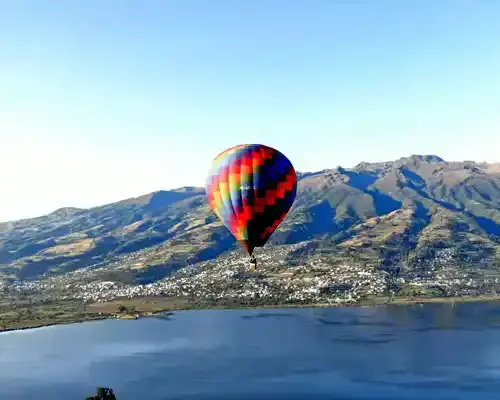
Otavalo Hot Air Balloon over Lago San Paulo
Fly in a hot-air balloon over Lago San Pablo near Otavalo. Marvel at bird’s-eye-views of the Andes and volcanoes as you soar at heights of over 1,000 feet. Enjoy the peace of sunrise and a wine toast.
Book on Get Your Guide →
*These are affiliate links. We may earn a small commission at no extra cost to you — thank you for helping us keep our adventures going!*
Family-Friendly Accommodations in Otavalo, Ecuador
If you’re looking for memorable family accommodations in Otavalo, I’ve put in a bit of legwork to find high-quality, local places to stay that will help make your trip even more amazing.
Great Places To Stay In Otavaloe
Ready to dive deeper into Otavalo? These hand-picked accommodations from Booking.com have great locations and easy access to all of the best things to do in the region.
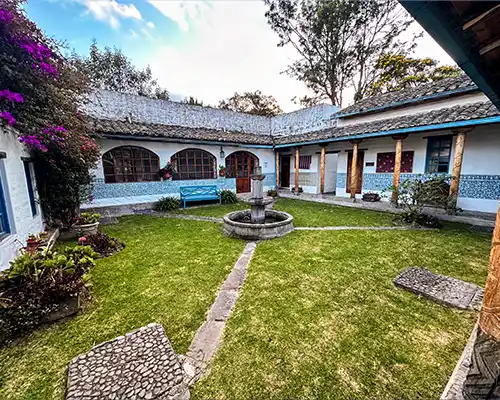
Hacienda Cusin
Set in a 17th Century colonial-style house only a 20-minutes drive from Otavalo craft market, Hacienda Cusin offers designated free WiFi areas. It features a restaurant and a garden.
Check the current rates on Booking →
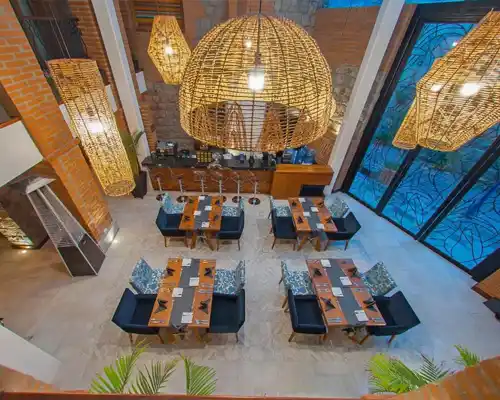
Hotel Otavalo by Art Hotels
Hotel Otavalo by Art Hotels in Otavalo offers luxurious rooms with private bathrooms, balconies, and views of landmarks. Each room features bathrobes, free WiFi, and modern amenities.
Check rates on Booking →
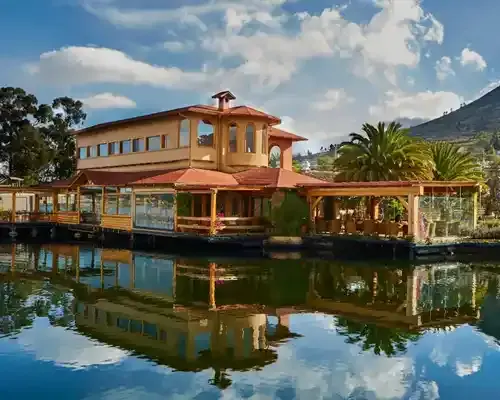
Hosteria Cabanas del Lago Otavalo hotel
Offering a restaurant, Hosteria Cabañas Del Lago is located in Otavalo, just steos from San Pablo lake. Free WiFi access and free private parking are available.
Check rates on Booking →
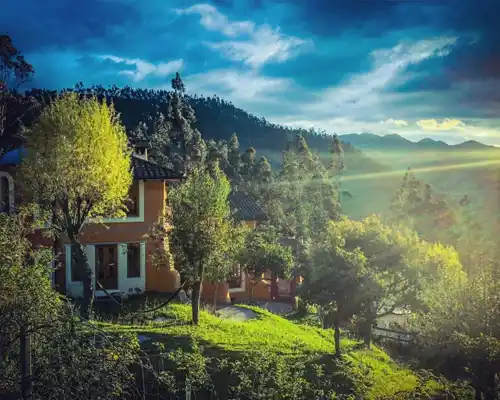
INTIYAYA Boutique Lodge
Crossed by a waterfall, this ethnic-style house in Peguche, 3 km from Otavalo, features rooms with views of the Andes and Valley of Dawn. Free Wi-Fi and parking are available.
Check rates on Booking →
*These are affiliate links. We may earn a small commission at no extra cost to you — thank you for helping us keep our adventures going!*
Do I Recommend Otavalo For Families?
If you’re looking for a relaxed destination in Ecuador with rich cultural experiences, lots of adventure, and a safe and immersive experience for families, Otavalo is hard to beat. This was, perhaps, our favorite town to visit on the mainland, and we really felt at home here.
Travel in Otavalo is quite easy, even for DIY families. This was one of our favorite places to visit in Ecuador, and I think that you’ll love it too.
If you’d love to connect with more family travel lovers, make sure to join our Family Travel Support Group on Facebook, an engaged community of travelers sharing tips, tricks, and advice for educational and immersive destinations.
You May Also Like To Read:

